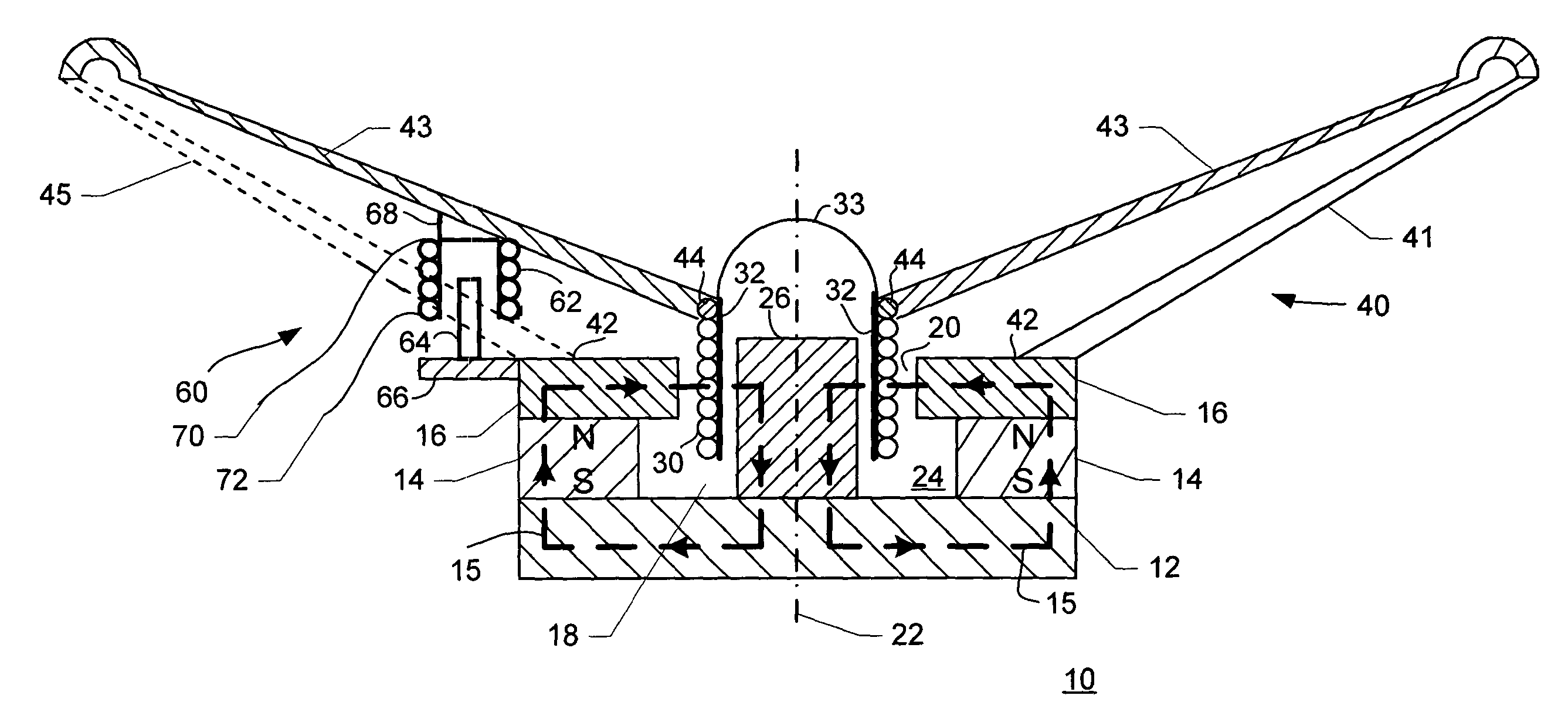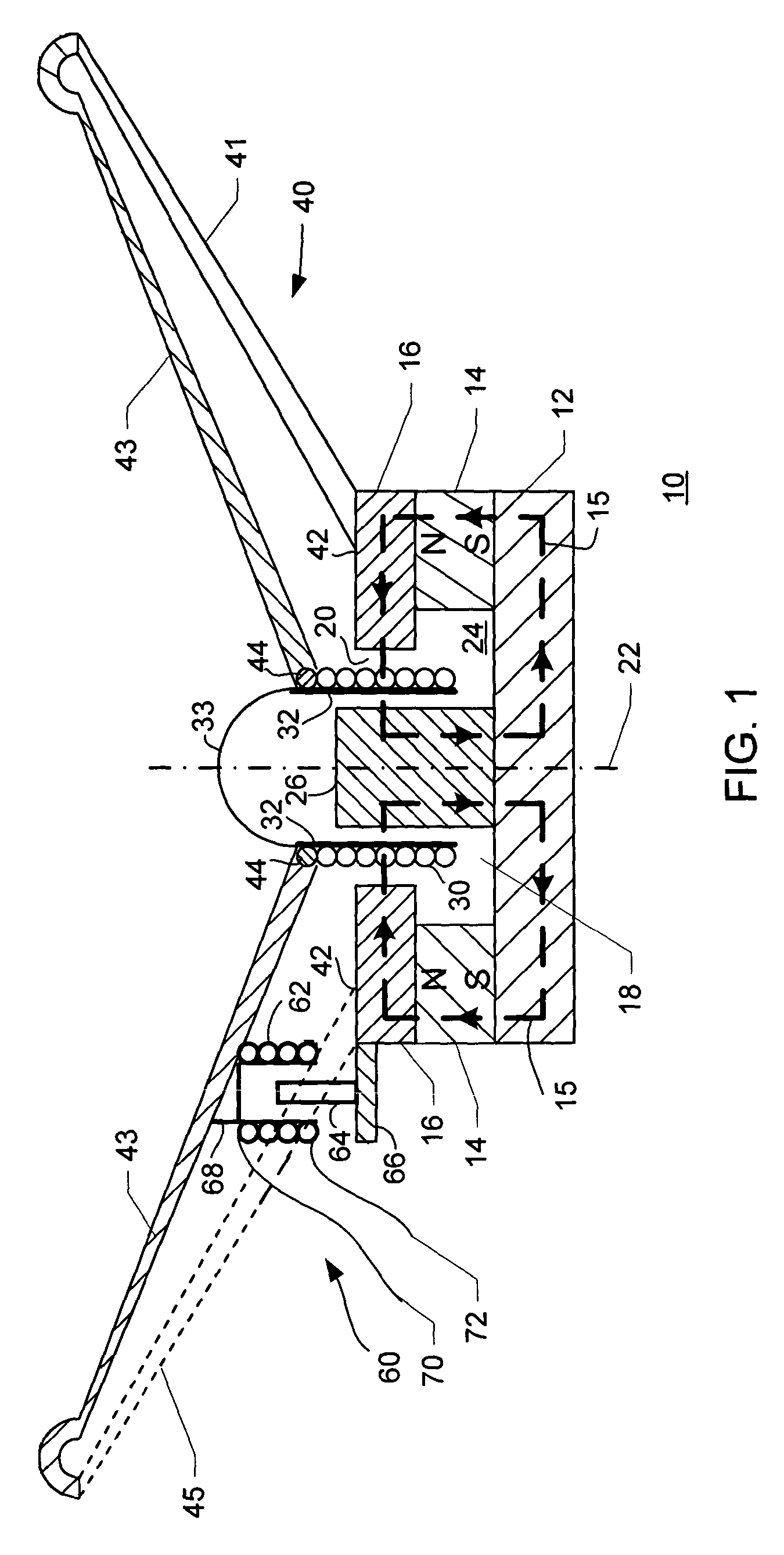Apparatus and method for monitoring speaker cone displacement in an audio speaker
a technology for audio speakers and antennas, applied in the field of antennas and methods for monitoring speaker cone displacement in audio speakers, can solve the problems of cone motion and the size and mass of sensors, significant distortion, and the cost of implanting sensors in the diaphragm of the speaker
- Summary
- Abstract
- Description
- Claims
- Application Information
AI Technical Summary
Benefits of technology
Problems solved by technology
Method used
Image
Examples
first embodiment
[0021]FIG. 1 is a schematic partial section diagram of a speaker using the apparatus of the present invention. In FIG. 1, a speaker 10 includes a bottom plate 12, a permanent magnet 14 affixed to bottom plate 12 and a top plate 16 affixed to permanent magnet 14. Permanent magnet 14 has an aperture 18 substantially oriented about an axis 22. Permanent magnet 14 has a north pole N and a south pole S. Top plate 16 has an aperture 20 oriented about axis 22. Apertures 18, 20 cooperate with bottom plate 12 to establish a cavity 24 within which is affixed a ferrous pole piece 26. A voice coil 30 is situated in part within cavity 24 oriented about pole piece 26 wound upon a voice coil bobbin 32. An air gap is established between voice coil 30 and top plate 16 when speaker 10 is in an assembled orientation with pole piece 26, bobbin 32 and voice coil 30 installed in cavity 24. A dust cap 33 may be integrally formed with or attached to bobbin 32. In the assembled orientation, magnetic flux (i...
second embodiment
[0028]FIG. 2 is a schematic diagram of a portion of a speaker using the apparatus of the present invention. In FIG. 2, sensor apparatus 61 includes an electromagnetic coil structure 62 and a ferrous core structure 64. Electromagnetic coil structure 62 is affixed to a supplemental top plate 66. Supplemental top plate 66 may be configured as an integral portion of top plate 16. Ferrous core structure 64 is affixed to cone 43 at the rear of cone 43. Ferrous core structure 64 is preferably affixed with cone 43 using wedge 68. Wedge 68 is preferably configured appropriately to cause ferrous core structure 64 to respond to motion by cone 43 in directions substantially parallel with axis 22. Wedge 68 may be eliminated or altered in mounting ferrous core structure 64. The angle between direction of motion of ferrous core structure 64 in response to motion by cone 43 and axis 22 may be mathematically accounted for in signal treatment circuitry (not shown in FIG. 2).
[0029]An input signal may ...
PUM
 Login to View More
Login to View More Abstract
Description
Claims
Application Information
 Login to View More
Login to View More - R&D
- Intellectual Property
- Life Sciences
- Materials
- Tech Scout
- Unparalleled Data Quality
- Higher Quality Content
- 60% Fewer Hallucinations
Browse by: Latest US Patents, China's latest patents, Technical Efficacy Thesaurus, Application Domain, Technology Topic, Popular Technical Reports.
© 2025 PatSnap. All rights reserved.Legal|Privacy policy|Modern Slavery Act Transparency Statement|Sitemap|About US| Contact US: help@patsnap.com



